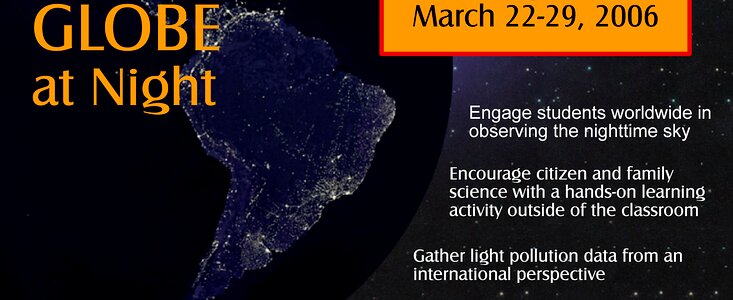Go Star Hunting with the “GLOBE at Night” Program—March 22- 29
2 Marzo 2006
What does it mean to REALLY see the stars? When you look at the night sky, are you awed by an endless swath of glittering jewels set against a deep velvet-black sky? Or do you see only a dozen or so pinpricks of light doggedly shining through the soft amber glow of streetlamps? How can light “pollution” make such a difference in the way the sky looks?
Classrooms, museums, and observatories in Tucson and elsewhere in Arizona will be joining thousands of other students, families, educators, and citizen-scientists by participating in “GLOBE at Night”—an international event designed to observe and record how the constellation Orion looks from different locations as a means of measuring the brightness of the sky at a variety of urban and rural sites. Participation is open to anyone—anywhere in the world—who can get outside and look skyward in the evening during the week of March 22-29, 2006. This week was chosen because the Moon does not rise until after midnight.
Media are invited to interview Tucson-area teachers and students, and to join them in making their observations during that week.
“The quality of the night sky for astronomy observations is affected by human activities. In turn, artificial lights with appropriate fixtures are necessary for safety and commerce,” says Dr. Connie Walker, a senior education specialist and scientist at the National Optical Astronomy Observatory (NOAO) in Tucson, one of the event’s co-sponsors. “By locating specific constellations in the sky, students from around the world will learn how extensively the lights in their community may contribute to light pollution.”
“In many parts of the world, a tremendous amount of precious electrical energy is being wasted through poorly designed and shielded streetlights. This program will help us better understand how we can more safely light our streets, save energy, and enjoy the night sky,” says Dr. Stephen Pompea, manager of science education and scientist at NOAO. “One of the program’s goals is to record 5,000 observations from around the world. We hope and expect that a fair fraction will come from Tucson, a city famous for its night-sky friendly streetlights and for being the headquarters of the International Dark-Sky Association.”
Students will explore the different light sources in their community to learn about the relationship between science, technology and society, and report their observations online through a central database, allowing for authentic worldwide research and analysis.
The observations made during GLOBE at Night will help students and scientists together assess how the quality of the night sky varies around the world. There is no cost to participate in GLOBE at Night.
Here’s How to Participate in GLOBE at Night!
- Visit http://www.globe.gov/globeatnight
- Download the GLOBE at Night Activity Packet (available in Spanish as well)
- Choose a clear night during the week of March 22-29, 2006
- Find the constellation Orion
- Compare what you see to the Magnitude Charts
- Report your observations on the Web site
- Sign up for the GLOBE at Night mailing list to receive the results of this international event!
What Students Will Learn:
- How to locate and identify constellations in the night sky
- How their view of the night sky is impacted by light pollution
- How science and technology have produced local and global challenges
- How light energy is distributed at local and global scales
- How effective and efficient different light sources are in their environment
- Some of the economic factors involved in light pollution in their community
- How to understand patterns of human population distribution
Más Información
For more information, educators can contact globeatnight@globe.gov or outreach@noao.edu.
GLOBE at Night is a collaboration between The GLOBE Program; the National Optical Astronomy Observatory (NOAO) in Tucson, AZ; Centro de Apoyo a la Didactica de la Astronomia (CADIAS) in Chile; Windows to the Universe; and Environmental Systems Research Institute, Inc. (ESRI).
The National Optical Astronomy Observatory (NOAO) consists of Kitt Peak National Observatory near Tucson, AZ; Cerro Tololo Inter-American Observatory near La Serena, Chile; and, the NOAO Gemini Science Center, the route for U.S. astronomers to observe with the Gemini North telescope in Hawaii and the Gemini South telescope in Chile. NOAO is operated by the Association of Universities for Research in Astronomy Inc. (AURA), under a cooperative agreement with the National Science Foundation.
Contactos
Douglas Isbell
Office of Public Affairs and Educational OutreachNational Optical Astronomy Observatory
Tel: 520/318-8230
Correo electrónico: disbell@noao.edu
Connie Walker
Office of Public Affairs and Educational OutreachNational Optical Astronomy Observatory
Tel: 520/318-8230
Correo electrónico: cwalker@noao.edu


